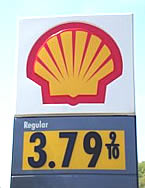Significant digits, the number of digits to the right of a decimal point that are warranted by the accuracy of the means of measurement, are a critical part of scientific investigation. In developing products and services, the concept is essential. For example, how many products have failed to “delight” customers because of tolerance stack-ups on component parts? And how many of those components have failed to meet spec because the significant digits of the design did not match the capability of the production process? In these cases, the number of places to the right of the decimal point is very significant.
|
But in many cases, the accuracy of our measures is insignificant. Take, for example, the price of gas at the pump. Why not $3.80 per gallon instead of the mixed decimal and fraction rendering we usually see? The answer is that during the 1930s  when gas price was 10–9/10 cents per gallon (equal to about $1.40 per gallon today), a penny was worth 10 percent of the price of the gallon—pretty significant.
when gas price was 10–9/10 cents per gallon (equal to about $1.40 per gallon today), a penny was worth 10 percent of the price of the gallon—pretty significant.
…
Add new comment